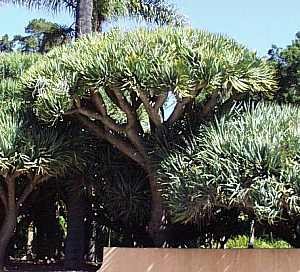Oh, yes, a beautiful plant @ctrl-alt-nwo and Dracaena draco (Dragon Tree) - An attractive and an interesting succulent tree that is commonly used as a house plant, but if planted in the ground in our near frost free climate it will grow to a massive and broad tree that is 25 feet tall and as wide and, with great age, even larger - one of the tallest ever recorded was over 70 feet tall. The terminal ends of the thick branches hold clusters of 2 foot long by 1 1/2 inch wide pliable sword-shaped blue-green leaves. In early summer appear the greenish-white flowers that are followed by orange berries. This plant remains unbranched until it flowers or is otherwise damaged and then produces two large heavy branches on either side of the inflorescence. When the bark is cut or bruised the sap flows as a reddish colored resin. This resin , one of the sources of a substance known as Dragon's blood can be used to stain wood. Plant in full sun or part shade. Water infrequently and deeply - do not allow the root zone to remain wet as this is the easiest way to kill this plant. It is hardy to about 20-25 degrees F - our tree in front of the nursery had foliage damaged but no lasting damage our in our 1990 freeze at 18 °F.
A very hardy and drought tolerant tree that tolerates extreme heat, winds and salt spray. This plant is native to the Canary Islands, Cape Verde, Madeira, and western Morocco and is the natural symbol of the island of Tenerife, the largest of the Canary Islands. It is on Tenerife where one can find the "Drago Milenario" (Thousand Year old Draco), a famous giant dragon tree located in Parque del Drago in Northern Tenerife that is believed by many people to be over a thousand years old, but others estimate it to be in the hundreds. Since monocots such at this do not form growth rings, the actual age of the plant is unknown, though the tree was declared a national monument in 1917. This species is on the International Union for Conservation of Nature (IUCN) List of Threatened Species Red List as Vulnerable (A1a-e) meaning that it is facing a high risk of extinction in the wild in the medium-term future for numerous reasons (loss of habitat, exploitation, competition etc). The name Dracaena comes from the Latin word 'draco', meaning "dragon" that was already used for the specific epithet for this same plant. This new name was ascribed by Linnaeus in 1767 when he renamed the plant originally called Asparagus draco. This species received the coveted Royal Horticultural Society's Award of Garden Merit (AGM) in 2002.
We have been growing this plant since 1982 and have a 30 year old specimen along the street at our nursery entrance. Though not included on most posionous plant lists, some references claim that seed of the Dracaena draco is posionous, while others such as on the California Poison Control System, list it as safe plant. Since this contradictory information exists, we err on the side of caution, and list it as poisonous, though we cannot verify the validity of this or what the posionous active ingredient would be. This description is based on our research and observations made of this plant as it grows in our nursery, in the nursery garden and in other gardens that we have visited.
https://www.smgrowers.com/products/plants/plantdisplay.asp?plant_id=530


